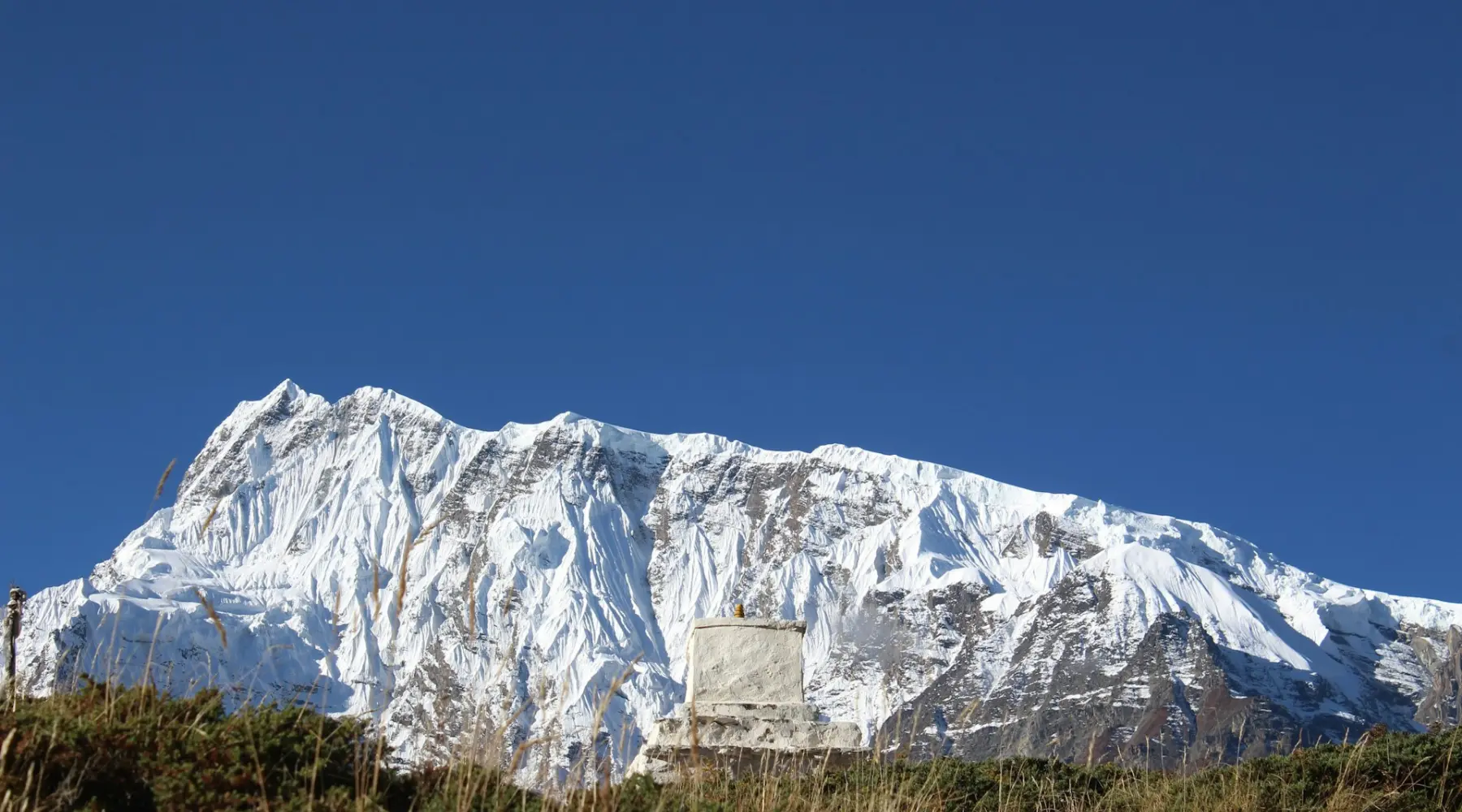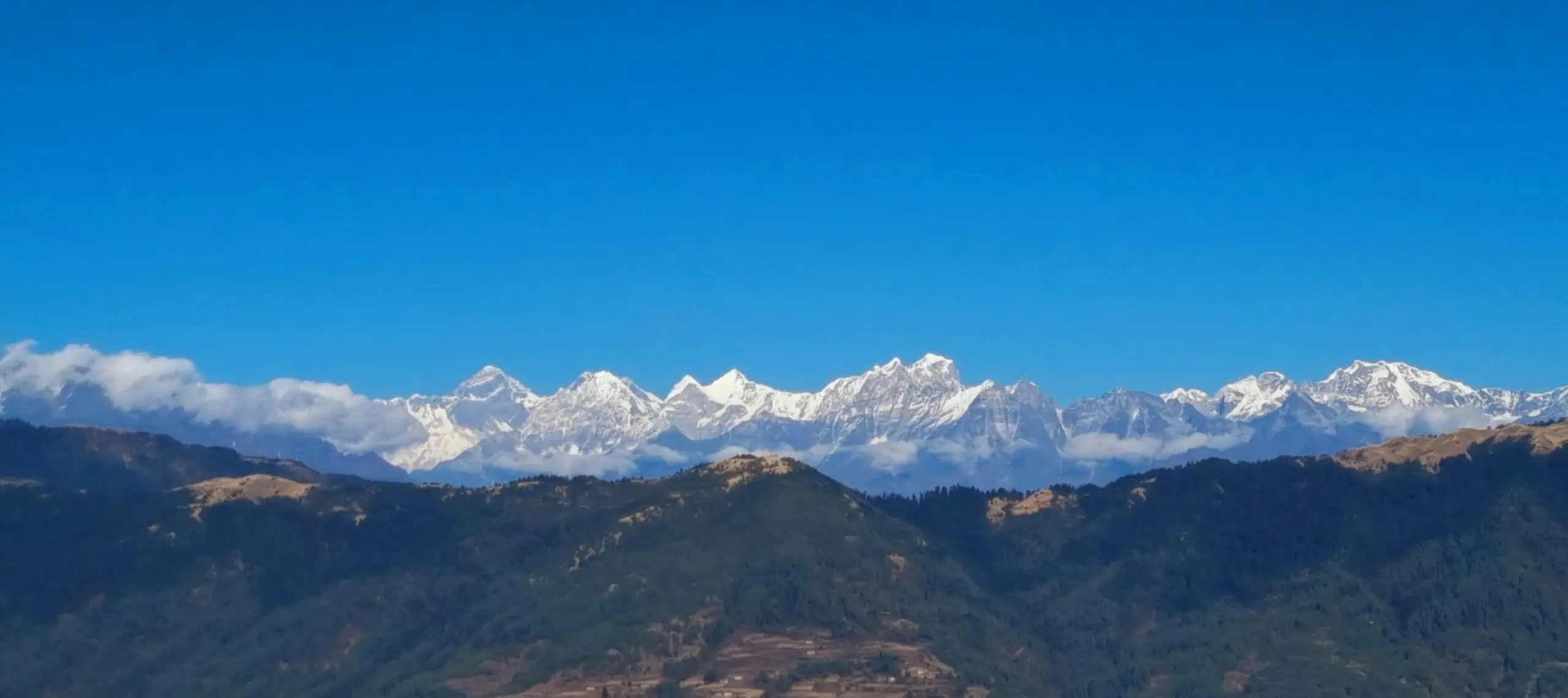
Manang Valley and Annapurna Circuit Trek 15 Days
USD 1,390
USD 1,290 per person
| Activities | - | Fitness Level | Moderate |
| Max Elevation | 5416m | Commute | Kathmandu to Beshishahar |
| Best Month | Autumn,Spring | Group Size | Min: 2, Max: 10+ |
| Arrival on | Kathmandu | Depart From | Kathmandu |
| Meal | B L D | Duration | 15 Days |
| Stay | Hotel & Tea House | Price | USD 1,290 per person |
Manang Valley and Annapurna Circuit Trek is the incredible trek to isolated valley following the ancient Bonism clicking the entire Annapurna massif reaching the zenith Thorang-la Pass.
Annapurna Circuit Trek, two weeks of walking journey along the horse shoe shaped fascinating trail that encircles amazing Annapurna is the world’s most popular trek beyond doubt. It is the most frequented trek in Nepal as well. The trek highlights exceedingly beautiful Manang Valley settled by the endogenous Gurung. The cultural encounters in numerous ethnically inhabited villages are the wonders of Nepal’s cultural diversity seen during the trek. The floral and faunal biodiversity of Annapurna Conservation Area Project are great sights. The rawness of nature that include pure cascading waterfalls, Rocky Mountains and deep gorges are mesmerizing. The most important highlights of the trek is the Himalayan vista from the top of Thorung La Pass. The incredibly adventurous walk to the top of Thorung La Pass and down to Muktinath is beautifully challenging. The shifting views of Annapurna and its neighboring peaks are always the prime highlights of Annapurna Circuit Trek. Last but not the least Jomsom the last stopover point of the trek is simply an icing on the cake. In addition, if you wish to enjoy natural beauties, enhance cultural experiences of Annapurna Region, you could join our Round Annapurna Trek-19 Days. Meantime, the best alternative of this trek is Tilicho Lake and Annapurna Circuit Trek-15 Days. If you are not satisfied with this itinerary or if you want to customize this package in your timeline or budget, then you could contact us, or email to [email protected]
Outline Itinerary:
Day 01: Arrive to Kathmandu & transfer to hotel (Altitude: 1350/4428 ft. Meal: Dinner)
Day 02: Drive Kathmandu to Syange via Besisahar (Altitude: 1100 m/3630 ft. Drive: 6/7 hrs. Distance: 205km Meal: BLD)
Day 03: Trek Syange to Tal Village (Altitude: 1675m/5494ft. Trek: 6 -7 hrs. Meal: BLD)
Day 04: Trek Tal Village to Timang (Altitude: 1943 m/6412 ft. Trek: 5-6 hrs. Meal: BLD)
Day 05: Trek Timang to Chame (Altitude: 2,630 m/8679 ft. Trek: 5-6 hrs. Meal: BLD)
Day 06: Trek Chame to Pisang (Altitude: 3,300m/10890 ft. Trek: 5-6 hrs. Meal: BLD)
Day 07: Trek Pisang to Manang (Altitude: 3,540 m/ 11680 ft. Trek: 5-6 hrs. Meal: BLD)
Day 08: Acclimatization day at Manang village (Altitude: 3,540 m/ 11680 ft. Meal: BLD)
Day 09: Trek Manang to Yak Kharka (Altitude: 4,000 m/ 13200 ft. Trek: 5-6 hrs. Meal: BLD)
Day 10: Trek Yak Kharka to Thorong Phedi (Altitude: 4,450 m/ 14685 ft. Trek: 5-6 hrs. Meal: BLD)
Day 11: Trek to Muktinath via Thorung La pass (Altitude: Thorung-la Pass: 5416 m/ 17873 ft. Muktinath: 3800 m/12540 ft. Trek: 7-8 hrs. Meal: BLD)
Day 12: Trek to Jomsom (Altitude: 2720 m/ 8976 ft. Trek: 5-6 hrs. Meal: BLD)
Day 13: Fly to Pokhara (Altitude: 823m/2,700ft Flight: 20 minutes Meal: B)
Day 14: Drive to Kathmandu (Altitude: 1350/4428 ft. Drive: 5-6 hrs. Meal: B/D)
Day 15: Depart Kathmandu (Altitude: 1350/4428 ft. Meal: B)
Costs
What is included?
🟢Airport transfer by Hiking Nepal office representative in a private vehicle
🟢Farewell Dinner at the finest restaurant in Thamel Kathmandu
🟢2 Nights’ accommodation at Tourist Standard Hotel in Kathmandu with breakfast on a sharing basis
🟢11 Nights’ accommodation at well and comfortable Mountain Lodge available en-route during trek (Few nights’ at during trek with attached bathroom/toilets)
🟢1 Night’s accommodation at 3-star Hotel in Pokhara with breakfast on a sharing basis
🟢 Full board meal during trek (Breakfast, Lunch, Dinner, tea & coffee, seasonal fruits, chocolate/s & biscuits)
🟢English speaking, First Aid and Eco-trained local trekking guide, Assistance guide as per the group size, porters (2:1)
🟢All the expenses for guide and porters along with Insurance
🟢Domestic Airfare and Tax for the sector Jomsom/Pokhara
🟢Kathmandu/Besisahar/ Syange drive in a public sharing vehicle
🟢Pokhara to Kathmandu transfer in a tourist sharing vehicle
🟢Annapurna Conservation Area Project (ACAP) fee
🟢Exclusive medical kit bag, Duffle Bag, Trekking T-shirt, Adventure Certificate
🟢Sleeping Bag and Down Jacket during Trek
🟢All government and local taxes as applicable
What is not included?
🔴Nepal Visa - (Cost- US$- 30 for 15 days & $- 50 for 30 days)
🔴Lunch & evening meals while in Kathmandu and Pokhara (Except welcome/farewell dinner)
🔴Travel insurance
🔴Cost of personal nature expenses, Beverages (Mineral water or coca cola), cost of extra meals, snacks, phones bills, Internet, WiFi, laundry etc.
🔴Cost incurred during the emergency, evacuations
🔴Tips for Guide/porters/driver ...
🔴Anything other than not mentioned in “Service Includes”
DETAILED ITINERARY
Drive to Kathmandu &Day 1: A transfer to hotel (Altitude: 1350/4428 ft. Meal: Dinner)-
The first view of Nepal from the window of your plane could be a lifetime memorable view as the clear wide and white range of Himalayas shine straight in-front of your eyes. The ecstatic beauty is so rare that you won’t be able to blink your eyes. Welcome to Nepal; a large heaven within this small planet Earth. As you step out of the airport our representative and a driver will receive you with a pleasant smiling welcome. Then, you will be escorted to hotel and take complete care in processing your check-in into the hotel. Evening, we, Hiking Nepal team will offer you a welcome dinner at authentic restaurant serving Nepalese cuisine with cultural dance show.
Day 2: Drive Kathmandu to Syange via Besisahar (Altitude: 1100 m/3630 ft. Drive: 6/7 hrs. Distance: 205km Meal: BLD)-
After breakfast, you will check-out from hotel to drive to Syange. You will drive along the snaky Prithivi Highway until Dumre followed by a bumpy ride beyond Dumre. After a long drive via Besisahar, you will arrive at Syange. Upon arrival at Syange, savor the stunning snow-capped views of Himalayas. Spend overnight at local lodge.
Day 3: Trek Syange to Tal Village (Altitude: 1675m/5494ft. Trek: 6 -7 hrs. Meal: BLD)-
Today is the beginning of trekking. Treading along the woodlands of ACAP and savoring the magnificence of Marsyangdi River Valley, you will arrive to Tal. Today’s trek comprises crossing over Marsyangdi River on a suspension bridge quite a few times and the cultural encounter at Jagat is worthwhile watching. The views of cascading waterfalls and Himalayan peaks like Mt. Lamjung (22,291Ft.), Manaslu (26,760 Ft.) and Peak 29 (24,652 Ft.) are tremendous rewards of today’s trek.
Day 4: Trek Tal Village to Timang (Altitude: 1943 m/6412 ft. Trek: 5-6 hrs. Meal: BLD)-
The whole day trek is wonderful. The landscapes dominated by lush vegetation, rivers, and mountains are refreshing. The cultural aspects during today’s trek are so fascinating. During 5-6 hrs trek we walk through wonderful culturally rich villages like Kharte, Dharapani, Bagarchhap and Danaque before we arrive to Timang for the overnight stay.
Day 5: Trek Timang to Chame (Altitude: 2,630 m/8679 ft. Trek: 5-6 hrs. Meal: BLD)-
The trail ascends to Tyanja at 2,360m, then traverses through forest, on a ridge above the river to Kopar 2,590m. After five hours of pleasant trek we arrive to Chame, the headquarters of the Manang district. At Chame, the view of Annapurna II and its closer proximity is overwhelming. You can also enjoy bathing in small hot springs in the neighborhood. The reward of today’s trek is when you explore Tibetan culture as the highland settlements belong to Tibetans who migrated centuries ago.
Day 6: Trek Chame to Pisang (Altitude: 3,300m/10890 ft. Trek: 5-6 hrs. Meal: BLD)-
Today, you will have a steep walk through dense forest into a narrowed valley. Crossing the raging Himalayan River at two points 2,910m & 3,040m are absolute highlights of the trek. Just crossing a suspension bridge at 3040m, the stunning view of Rocky Hill Paungda Danda feasts catch by the eyes. Beyond here, the course connects towards Pisang on a steep trail. Pisang, nestles between 3,200m and 3,300meters.
Day 7: Trek Pisang to Manang (Altitude: 3,540 m/ 11680 ft. Trek: 5-6 hrs. Meal: BLD)-
After breakfast, you will walk through the arid & higher region of Manang. As you trek higher, the region affected being at the rain shadow of Annapurna comes into sight. Natives of this county flock yaks most of the times of the year and cultivate crops for a very short period of the year. As you leave Pisang, you will tread along the northern via Ghyaru for the better views of the Himalayan peaks throughout the trail that chases along the northern bank of the river. Now, you will arrive to Munchi. Beyond Munchi, the trail passes the charming and the authentic village of Braga 3475m. The last push brings to Manang.
Day 8: Acclimatization day at Manang village (Altitude: 3,540 m/ 11680 ft. Meal: BLD)-
Today, a time for rest and acclimatize properly with altitude. However, it does not mean that you have to spend time by staying at lodge and read books. You can go for short walks to higher altitude around the village where you can witness more of raw nature of the region. Your guide is the best man to take you to the best destination.
Day 9: Trek Manang to Yak Kharka (Altitude: 4,000 m/ 13200 ft. Trek: 5-6 hrs. Meal: BLD)-
Today, you will trek to higher altitude. After a day rest in Manang, you will not have acclimatization issue. However, gaining 500 m height trekking along the gradual uphill climb is quite an adventure. As the trek begins, you will croesses a stream, climbs to a village of Tenki and continue to ascend the Marsyangdi Valley, turning northwest up the valley of Jarsang Khola. You will further passess the small village of Ghunsa and following the trail through the meadows. Here, you can see the horses and yaks grazing. Crossing a wooden suspension bridge, you will encounters series of mani wall, eventually, you reach Yak Kharka at 4,000m. Yak Kharka is the yak graze land and hence signs of yak herders and thin vegetation can be seen there. Overnight at Yak Kharka.
Day 10: Trek Yak Kharka to Thorong Phedi (Altitude: 4,450 m/ 14685 ft. Trek: 5-6 hrs. Meal: BLD)-
Today, you will walk uphill to the Thorang Phedi. Walking for a while in an easy trail, you will sross a suspension bridge leading you towards Ledar village. Then, slightly ascend and passing through towering cliffs, you will reach at Thorang Phedi. It is the last village before Thorang-la Pass. During the trail, you can click the views of Mt. Gundang, Thorang Peak, Mt. Syangang and Mt. Khatungkan. Overnight in Thorang Phedi.
Day 11: Trek to Muktinath via Thorung La pass (Altitude: Thorung-la Pass: 5416 m/ 17873 ft. Muktinath: 3800 m/12540 ft. Trek: 7-8 hrs. Meal: BLD)-
Here comes most exciting and adventurous time as you are going to cross the world’s largest pass- The Thorong-la pass. Hence, today’s trek will be lengthy, you will starts trek early. Five hours of steep strenuous walk from the camp at Thorung Phedi brings you to the top of Thorung La Pass 5416m. The regular course to Thorung La Pass seems easy. However, a number of difficulties might encounter due to the elevation and snow. Getting up to the pass may be tough but the acme of the pass marked by revered chortens and colorful prayer flags will reward you with the most eye-catching views of Himalayas that include Annapurna at its best.
Day 12: Trek to Jomsom (Altitude: 2720 m/ 8976 ft. Trek: 5-6 hrs. Meal: BLD)-
You will descent through the Kali Gandaki Valley to Jomsom, the windy city & the home to the apple orchard of Nepal. Coming down hill, you always have to be cautious and not be excited to reach the destination. Spend overnight at local lodge.
Day 13: Fly to Pokhara (Altitude: 823m/2,700ft Flight: 20 minutes Meal: B)-
From the windy city Jomsom and you will take a flight back to Pokhara. Leaving the tranquil isolation, as you land at Pokhara, you will be once again transferred to your hotel in the city. Rest of the time at your own.
Day 14: Drive to Kathmandu (Altitude: 1350/4428 ft. Drive: 5-6 hrs. Meal: B/D)-
While driving back to Kathmandu the 1st half of the trip is along the highway above Seti and Marsyandi Rivers and the latter half winds along Trisuli River. Green hills along the spiral roads, stopping in between for snacks (fish) are the trip highlights. Upon arriving at Kathmandu, you will be transferred to the hotel in the city. Take your time for refreshment. Evening, we, Hiking Nepal team, invite you for a dinner. Give us chance to make your evening a wonderful time.
Day 15: Depart Kathmandu (Altitude: 1350/4428 ft. Meal: B)-
Our tour officer will pick you up from your hotel three hours prior to your departure time. You will be escorted in a private vehicle to the airport for your final departure. Have a safe flight home.
DEPARTURE DATES
| START DATE | END DATE | STATUS | PRICES |
|---|---|---|---|
| No departures found for November | |||
FAQ
No FAQs available for this tour.
REVIEWS
RELATED TRIPS

Sunder Peak Trek
Sunder Peak, a short trekking in the Everest Region follows the traditionally and historically impor...
More Details
Pikey Peak Trek
Pikey Trek- short and outstanding trekking to the Himalayas viewing the stunning Himalayas including...
More Details
| 1 person | 2-7 person | 8+ person |
|---|---|---|
|
$ 1,290
Partial Pay
|
$
1,199
/ per
Partial Pay
|
$
1,145
/ per
Partial Pay
|




- Speak to one of our travel consultants
- Call Us (24/7) : +977 9802342080
-
 WhatsApp (24/7) : +977-9802342080
WhatsApp (24/7) : +977-9802342080
Planning a Trip?
We have a pool of travel experts working in this industry for more than a decade. Consult to get started
BOOK A CALL